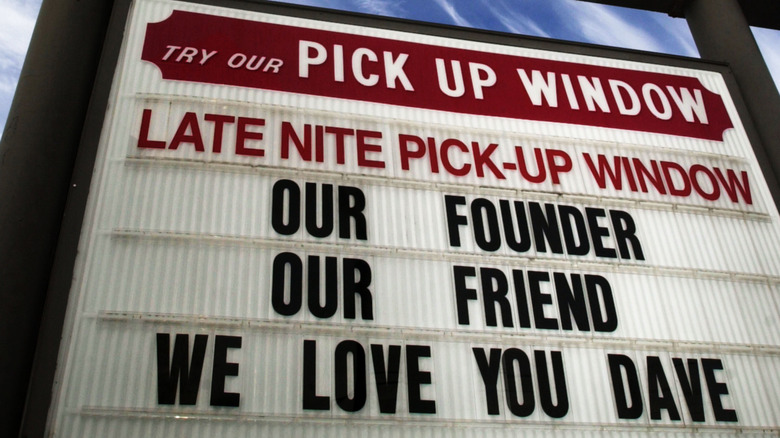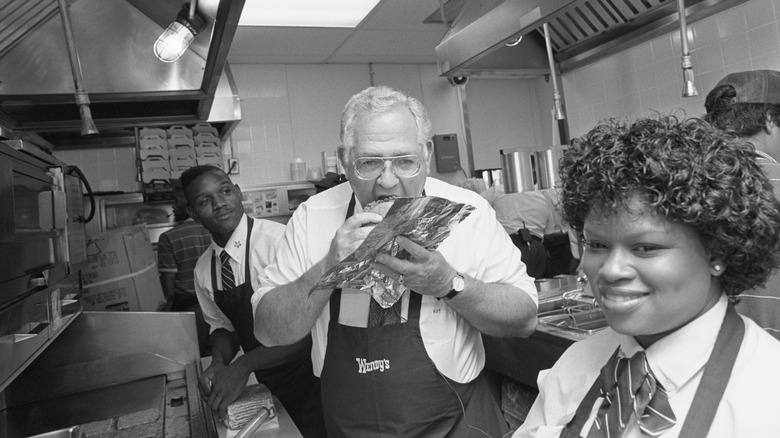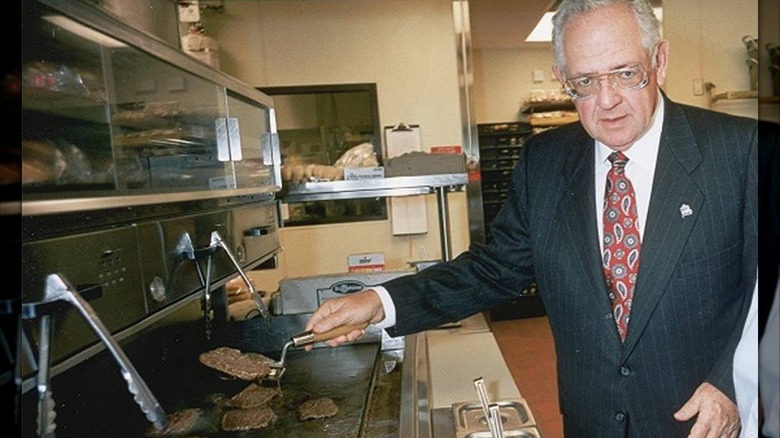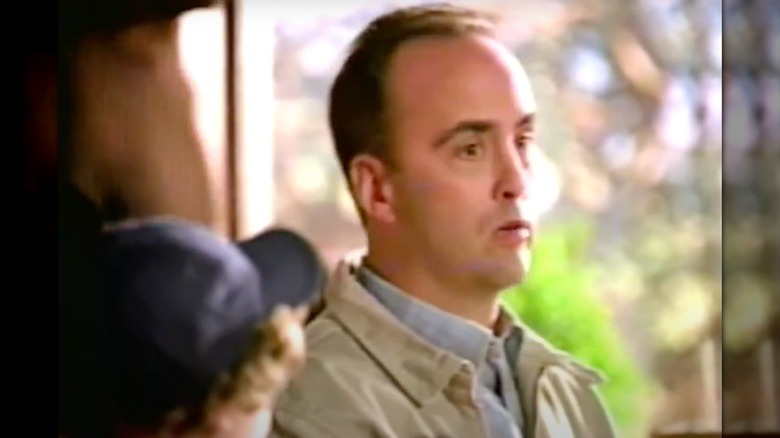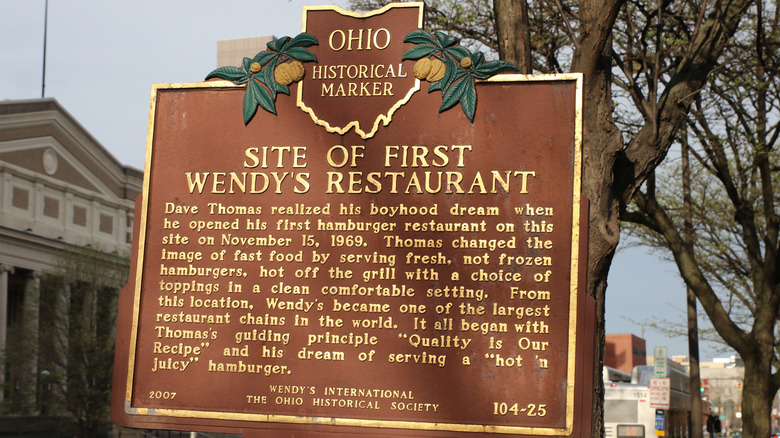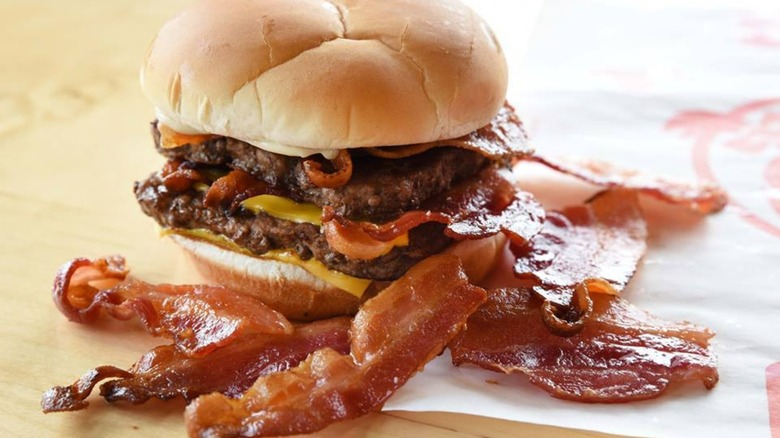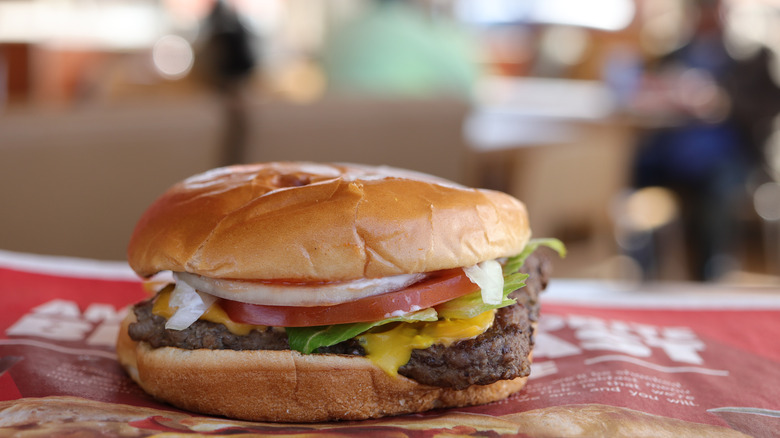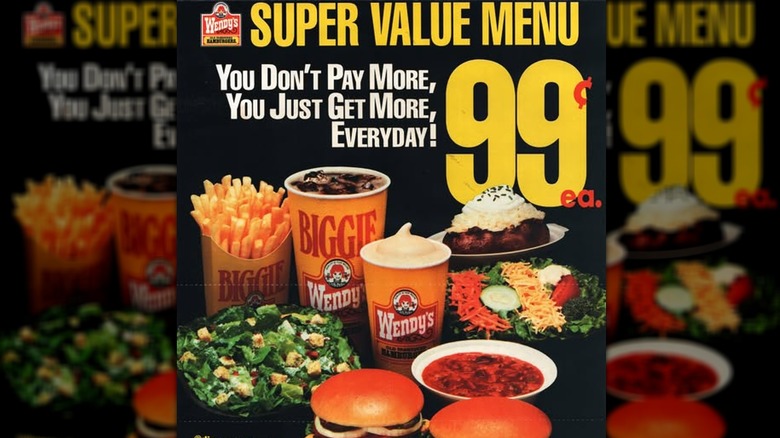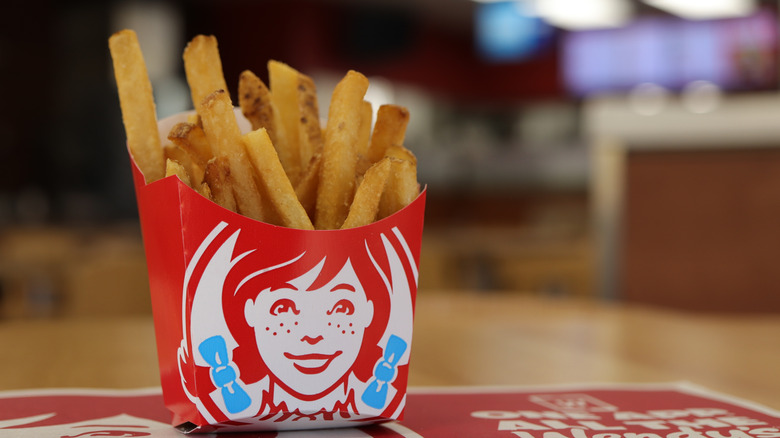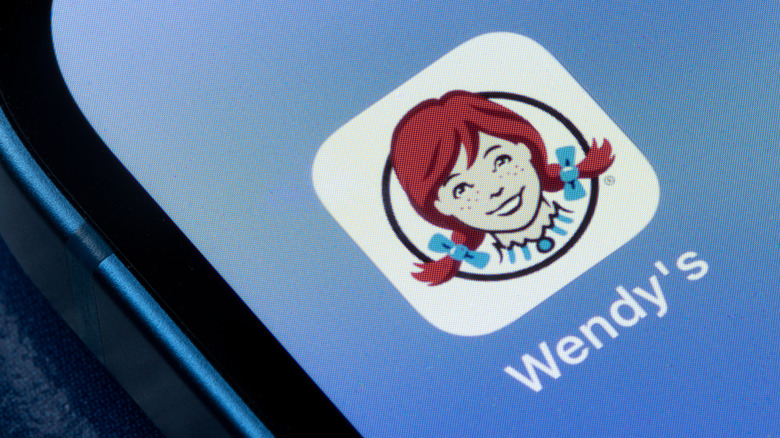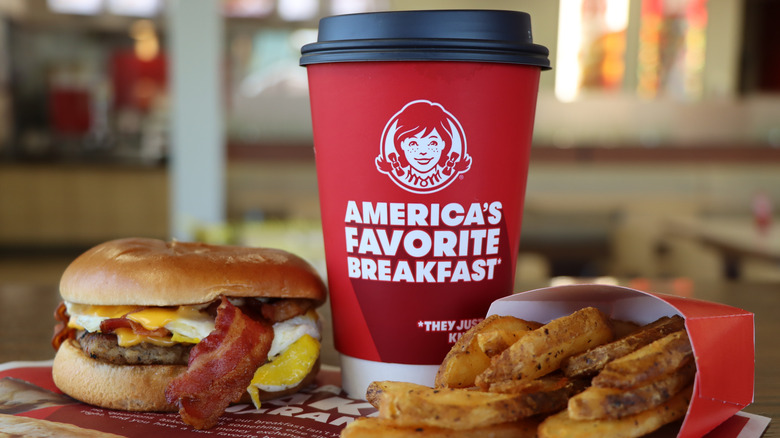Wendy's Was Never The Same After Founder Dave Thomas Died
Dave Thomas was a constant presence at Wendy's from the day he founded the restaurant in 1969 until his death 33 years later. The iconic square burgers, beefy chili, and famous Frosty all launched with his original simplified menu. Thomas' franchising expertise transformed Wendy's from a small, regional enterprise in Ohio into a national chain with over 1,400 locations by 1978. It's fair to credit Thomas as the main driver behind Wendy's becoming a global fast food juggernaut. So it's no wonder that the chain was never the same after the founder died of cancer in 2002 at age 69. Thomas would later say that there was no secret to his success — it came down to "persistence" and having "a passion for the business."
While Thomas stepped down as chief executive in 1982, he kept an eye on operations as senior chairman and did not like what he saw. Wendy's president convinced him to officially return after three years as the chain was faltering with quality control. If Wendy's hit a rough patch during this relatively short absence, imagine the crisis that ensued when he passed away. The chain continues to hold closely to the Thomas legacy, still touting his "quality is our recipe" slogan and proudly keeping his picture in many of its dining rooms. However, today's Wendy's is quite a different place from when Thomas first served a single burger over half a century ago.
When Dave Thomas died, Wendy's lost a fast food pioneer and its spokesman
Having cut his teeth under mentors like KFC founder Colonel Harland Sanders before breaking out on his own, Dave Thomas was as experienced as they come in the fast food business. When he died, Wendy's lost an innovator who understood the nuances of the industry.
Thomas was one of the first to see how drive-thru windows could change fast food eating forever. Today, fast food restaurants and drive-thru windows go together like, well, burgers and fries. That wasn't the case in 1970 when he perfected the concept at the second Wendy's. Thomas was also forward-thinking when the chain started franchising in 1973. Instead of selling one location at a time, Wendy's granted regions to franchisees. Owners were then expected to establish a presence in their territories and expand. The strategy helped set up a growth boom that made Wendy's the third biggest burger chain (behind McDonald's and Burger King) 30 years after opening its first store.
However, the role Thomas took at the end of the '80s — TV commercial star — was just as significant for Wendy's long-term growth. After the chain's previously successful "Where's the beef?" campaign starring Clara Peller fizzled out, Wendy's was without a spokesperson. Thomas reluctantly took over the role in 1989 and initially had an awkward on-camera presence. Eventually, the founder developed a folksy yet self-deprecating persona that was a hit with audiences. He went on to star in over 800 Wendy's commercials over nearly 13 years.
With Dave Thomas no longer visiting franchises, so went his mop bucket attitude
When Dave Thomas came out of semi-retirement in the 1980s, his first mission was to transform the company culture. The only antidote to an apparent epidemic of mediocre quality and slumping sales was a dose of "mop bucket attitude," aka the work ethic of putting the customer first and never cutting corners. To instill this mindset, Thomas traveled across the country and worked directly with franchisees. He wanted them all to get an MBA — a degree in "mop bucket attitude" — and it ultimately had a positive effect. As someone who did a lot of mopping and cleaning in the early days, Thomas felt these humble tasks built character and improved restaurants.
While Wendy's no longer has a founder traveling from store to store, some franchisees have been around long enough to remember his visits. They say Thomas made a point to connect with everyone, from the owner to the crew members. He would make everyone feel like their role was essential and was known to show his method for dressing burgers and would even work the drive-thru window. Thomas said he never considered himself a great leader, but he always followed through on tasks and treated people with respect. The approach resonated with employees. While Wendy's continues to honor "Dave's way," they've had to make do without a singular figure who can inspire the workforce.
Failed ad campaigns like Mr. Wendy showed a lack of marketing focus in the aughts
Wendy's was backed into a corner after Dave Thomas' passing in 2002. His commercials were so identifiable with Wendy's that marketing heads struggled to find a new direction. While the chain prepared for the inevitable by testing some different campaigns, Thomas continued to appear in ads up until his death. The advertising team subsequently edited him out of existing commercials and moved ahead with new campaigns that tried to strike the same folksy chord but without its founder. These ads often featured family-friendly humor along with references to Wendy's headquarters in Dublin, Ohio, and food prepared "Dave's way." These were half-hearted attempts at maintaining the status quo.
However, the results were even worse when Wendy's tried to introduce a new spokesman with the drab "Mr. Wendy" campaign a few years later. In these TV spots, an unassuming "unofficial spokesman" finds ways to intrusively converse with strangers about Wendy's food. The campaign got axed in late 2004 after a tepid response and criticism that the ads focused more on the character than the food. In Mr. Wendy's defense, it's not easy following a founder who appeared in enough commercials to earn a place in the Guinness Book of World Records. The chain's marketing reputation was so bad that its use of the Violent Femmes song "Blister in the Sun" was cited in a 2007 inter-band lawsuit. By the end of the aughts, the marketing team steered away from humor with an animated Wendy's campaign.
Dave Thomas' original Wendy's closed its doors in 2007
The experience of eating at the first Wendy's was quite a bit different when it opened in Columbus, Ohio, back in 1969. The floors were carpeted, men on staff wore black bow ties, and the vibe was a tad fancy and pricey for the time. However, the original menu featured the Frosty, chili, and burgers made from "fresh, never frozen" beef. For sentimental reasons, Wendy's kept the original location running as long as possible, even though low sales made it a financial drain. In 2007, executives finally caved to lost revenue and closed the first restaurant, which doubled as a small museum.
The company spokesman at the time said the founder would have approved. After all, one of the five values that Thomas championed was "profit is not a dirty word." The original restaurant struggled due to several practical issues, including a lack of parking, no drive-thru window, and ongoing maintenance problems. Its downtown location being blocks from the Ohio Statehouse didn't help either. The restaurant suffered on evenings and weekends when government buildings were closed. While the decision made financial sense (even if they could keep over 6,000 other locations operational at the time), it certainly marked the end of an era. Some of the memorabilia on display at the first Wendy's included Thomas' old hamburger griddle and his daughter's iconic blue-and-white dress that inspired the company logo.
Wendy's chased younger demographics with the Baconator in 2007
How do you get kids interested in your food when your restaurant literally says "old-fashioned" on the sign? Well, in 2007, the secret to scoring big with the prized 18 to 34-year-old demographic was more bacon. The Baconator, which consists of six strips of bacon and two quarter-pound beef patties topped with cheese, was initially released as part of a "back to basics" turnaround plan led by new CEO Kerrii Anderson. While Wendy's had bacon-topped cheeseburgers in Dave Thomas' day, this 970 calorie beast was a whole new ball game.
You might think a bacon cheeseburger shamelessly targeting young adults with a name evoking an action movie would fail spectacularly. The truth of the Baconator is that it was an immediate hit right when Wendy's needed to catch a break. At the time, the chain was for sale and still reeling from failed menu experiments like 2006's Frescata sandwiches. Wendy's turned away from the post-Super Size Me health bandwagon and instead anticipated baconmania before it caught fire in the 2010s. Wendy's sold 68 million Baconators within a year, and it was a hit with the younger, late-night crowd. It has become a Wendy's menu mainstay and spawned offshoots like the Son of Baconator, Breakfast Baconator, and Baconator Fries.
Wendy's 2008 merger with Arby's did not go over well with the Thomas family
Between weak sales, directionless marketing, and a fraudster claiming she found a finger in her chili, the mid-2000s were tough for Wendy's. It was in this climate that the Wendy's board agreed to a buyout by billionaire investor Nelson Peltz, who led the parent company that also owned Arby's. News of the merger in 2008 devastated the Thomas family, who pushed for an alternative bid from a Wendy's franchise owner. Thomas' daughter Pam Thomas Farber said her father "would not be amused" by the buyout if he were alive and she openly speculated that the new owners could relocate Wendy's headquarters from Dublin, Ohio (via 10 WBNS).
An activist investor known for shaking up corporations, Peltz initiated his takeover strategy in 2005 by purchasing shares and advocating for a reduction in corporate staff. The Wendy's board rejected his first two bids but ultimately gave in as it became clear they would not get a better offer. The all-stock deal merged Wendy's and fellow fast food chain Arby's with the goal of creating a bigger business with fresh leadership. However, the Great Recession threw a wrench in these plans, and the group sold Arby's by 2011. The Thomas family may have had a point about this deal being the wrong move, but at least Wendy's headquarters stayed in Dublin.
Wendy's changed its Dave's classic burger recipe in 2011
Wendy's may have updated its menu with wraps, nuggets, and deli sandwiches over the years, but it never dared touch its classic burger recipe. The classic Single, Double, and Triple essentially remained the same since Thomas opened the restaurant in 1969. That all changed in 2011 when the chain revamped its classics with its "Dave's Hot 'N Juicy" rollout.
Of course, the burger was still square, but it was bigger and a bit saltier, according to reviews at the time. Wendy's also swapped in a buttered, toasted bun and new "premium" toppings, including red onion (previously white) and crinkled pickles (previously plain). The change that probably wouldn't please the late Thomas was removing the mustard — he was on record saying his favorite burger was a Double with pickle, onion, and mustard.
Before releasing the Hot 'N Juicy upgrades, Wendy's spent two and a half years researching and perfecting the tweaks through a new approach called Project Gold Hamburger. If that sounds a bit militaristic, it's because Wendy's knew it had to plan this invasion just right. The chain was losing its share of the burger market to McDonald's and fast-casual upstarts like Five Guys and needed a shakeup. This mission, which came soon after the Nelson Peltz buyout, was partially successful. The classic Dave's lineup of burgers still has many of the 2011 upgrades, albeit with white onions and mustard back between the bun.
The original Super Value Menu became more expensive
In 1989, Wendy's unleashed its Super Value Menu on a public eager to go a la carte on the cheap. That first lineup, which Wendy's claims introduced the value concept, included nine items, all priced at 99 cents. It changed value menus forever, even at a time when gas also cost a buck per gallon on average. Customers could piece together full meals with a selection of smaller items like fries, junior burgers, and chicken nuggets. The dollar price tag made everything ultra-simple for cash-strapped patrons.
To its credit, Wendy's maintained the 99 cent charge well into the aughts, even if it dropped options like the baked potato and reduced the soft drink size. However, it was only a matter of time before inflation caught up with profit margins. Wendy's conducted an off-and-on "experiment" of raising the prices of some value menu items in 2006. It started innocently enough with a Junior Bacon Cheeseburger jumping to $1.29 and kept creeping from there. Wendy's ditched the Super Value Menu moniker in 2013, swapping in the "Right Price Right Size" menu with options ranging up to $2. Today, the chain has "Biggie Deals," which includes the Junior Bacon Cheeseburger at over $3.
Some customers have not been happy with the food changes
Any restaurant with a nostalgic fan base is likely to face backlash when it makes changes. If you mention Dave Thomas to a longtime Wendy's customer, you're sure to get a lecture on how the restaurant has gone downhill. Reddit's Bring back the old Wendy's thread is rife with observations on unpopular changes, from the honey mustard flavor right down to the patty size (where's the beef, anyone?). The chili is another symbol of decline — while rumor has it that employees now use day-old hamburger meat, some swear they cooked fresh chili meat decades ago.
However, customers on the thread saved their sharpest criticism for the new Wendy's fries, which got revamped in 2021 to stay hotter and crispier for longer. The update was two years in the making as the chain wanted its fries to stay warm with the increase in delivery orders. While customers acknowledged that the older fries would get soggy fast, many claim the updated recipe is a flavor downgrade. However, it's tough to say if the change was as big of a flop as the failed Frosty flavor experiments over the years. After all, who wants to dip any fries in a vanilla Frosty?
Wendy's went from old-fashioned to tongue-in-cheek marketing with its social media strategy
To those who remember the gentle humor of Dave Thomas' commercials, Wendy's sarcastic and sometimes edgy social media content is downright jarring. The closest Thomas came to roasting other restaurants was his "traveling the world" ad series, where the punchline was that an unpretentious burger is better than escargot. The chain's social media strategy centers around "beefing" with competitors, and Wendy isn't afraid to get sassy. Some of Wendy's famous beef targets have included Dunkin' (over its spicy donuts), McDonald's (over its broken ice cream machines), and most recently Katy Perry (over returning to Earth).
In the late 2010s, Wendy's abandoned its safe, bureaucratic SMM strategy and adopted the irreverent "First Lady of Fast Food" persona. The social media team has gone out of its way to engage consumers, anticipate viral trends, and craft scathing comebacks to naysayers. This snarky approach to social media has been critical in attracting Gen Z consumers who've probably never heard of Dave Thomas. The First Lady of Fast Food has certainly gone too far at times, but it's hard to deny that the strategy has been a success. Wendy's lags behind bigger chains in terms of overall followers, but its Twitter account often gets national attention.
After many setbacks following Dave Thomas' death, Wendy's surpassed Burger King in the 2020s
Wendy's was solidly the third top burger chain in the U.S. for most of its existence. No one is going to surpass mighty McDonald's, but Burger King always seemed within reach. The house that Dave Thomas built finally dethroned the King to take second place in 2020. That year, Wendy's saw its sales rise 4.8% to $10.2 billion while Burger King's dropped 5.4% to $9.6 billion, according to Technomic figures reported by Restaurant Business. It was the culmination of many tumultuous years that included unsuccessful marketing choices, an activist investor buyout, and mixed reactions to menu changes. However, the chain stood its ground in the burger wars despite the drama. Thomas would have been proud.
Of all things, breakfast was the deciding factor that pushed Wendy's ahead of Burger King. The morning meal had always been the egg that even Thomas couldn't crack. Wendy's first introduced breakfast in the 1980s with a menu that included omelets, which Thomas admitted were too difficult to quickly prepare in a made-to-order style. Following that failure, the chain stayed out of the morning space until dipping its toes with gradual breakfast launches in 2006 and 2012. Neither took off, but the chain was back at it in 2019. This time, Wendy's went for a national rollout and put the full might of its social media arm behind the campaign. Turns out the fourth-ish time was the charm, as Wendy's breakfast burritos, biscuits, and croissants are still going strong.
